Welcome to April’s #FacetsOfME where we will focus on loneliness and how this illness affects our need for connection and relationships. Loneliness can be difficult to discuss as contemplating our own loneliness and need for connection can make us feel very vulnerable. Loneliness is certainly not unique to ME but we will try to examine how our illness contributes to loneliness. The symptoms of post-exertional malaise, cognitive dysfunction, sensory sensitivity, etc. contribute to challenges with connecting.
I do not have numbers on how many people with ME experience loneliness on a regular basis, but from what I see in our support groups and on social media, it is common. We do know that in the United States, 40 percent of people who say that they have a debilitating disability or chronic disease report experiencing loneliness and social isolation. Perhaps this could be helpful to some of our fellow spoonies as well. This one might be difficult to dive into but hopefully doing it together will ease the discomfort and I think we might come out better for it on the other side. Are you ready? Get comfortable and take all the breaks you need. If at any point you need to reach out to speak with someone, please see these crisis resources.
What is Loneliness?
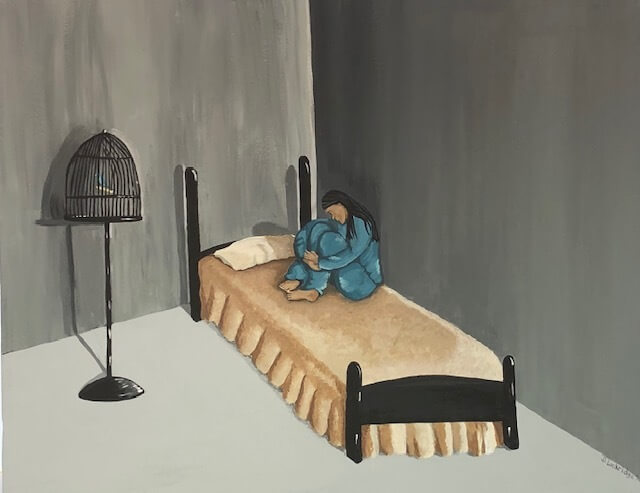
When it comes to discussing loneliness, I think it is important to start with making sure we have a shared understanding of the language around loneliness and connection.
“Loneliness is the state of distress or discomfort that results when one perceives a gap between one’s desires for social connection and actual experiences of it.” Feeling lonely is not always about being alone. We can feel alone in a crowded room but in the case of our illness, being forced into spending a lot of time alone is certainly a part of our loneliness. As humans, we have a need for connection. When we are not able to fulfill that need, we feel the loss. We feel lonely.
Loneliness is universal, so let’s first make sure we learn from what is known and then apply that to our specific circumstance of loneliness in relation to a chronic illness that makes visiting, conversations, and common social interactions anywhere from difficult to impossible.
Researchers have identified 3 dimensions of loneliness as described in the research article ”Loneliness: Clinical Import and Interventions”:
- “Intimate loneliness, or… emotional loneliness, refers to the perceived absence of a significant someone (e.g., a spouse), that is, a person one can rely on for emotional support during crises, who provides mutual assistance, and who affirms one’s value as a person.” It can be a small core group or one person.
- “Relational loneliness, or… social loneliness. It refers to the perceived presence/absence of quality friendships or family connections, that is, connections from the “sympathy group”…the “sympathy group” can include among 15 and 50 people and comprises core social partners whom we see regularly and from whom we can obtain high-cost instrumental support.”
- “Collective loneliness… refers to a person’s valued social identities or ‘active network’ (e.g., group, school, team, or national identity).”
The United States Surgeon General, Dr. Vivek Murthy, in his recent book Together describes the three dimensions this way: “Intimate or emotional loneliness is the longing for a close confidant or intimate partner, someone with whom you share a deep mutual bond of affection and trust. Relational or social loneliness is the yearning for quality friendships, and social companionship and support. Collective loneliness is the hunger for a network or a community of people who share your sense of purpose and interests. These three dimensions together reflect the full range of high-quality social connections that humans need in order to thrive.“
The idea that a deficiency or “perceived deficiency” in any one of these can cause you to be lonely. Now that we know the dimensions of loneliness, we can identify which dimensions are affected by this illness. Let’s look back and see…
Intimate loneliness? Check.
Relational loneliness? Check.
And finally, collective loneliness? Check.
All of them.
All three dimensions are affected by living with ME. Yay, us! (Read in sarcastic tone.)
Let’s start with intimate loneliness. Finding a partner in life is a challenge in general. Let’s add possibly being unable to leave your home or carry on long conversations, and well…it’s not easy. (I am not at all trying to make light of this but I do want us to be able to speak plainly here amongst ourselves). It is deeply personal and there is so much understandable grief in our community about it. It is not just about finding a partner either. It is maintaining and nourishing that type of relationship under trying conditions. Some of us had a life partner and then got ill. This has meant that some lost that relationship totally or are now having to adjust to a very changed version of the relationship. It has also allowed some to have a very deep satisfying relationship from two people deeply committed to each other, and to working things out. Not everyone can do that.
One very important note here is that it can also be another hindrance to leaving an abusive relationship. The dependence on a partner for the very basic activities for daily living can be a situation ripe for abuse.
If you are experiencing domestic abuse, please click below for resources.
Let’s move on to the next dimension of loneliness: relational (or social) loneliness—the need for friends and true companionship. I believe this is a loneliness that cuts deep in our community. Complex, misunderstood chronic illness can be hard on a friendship.
For friendships already in existence, once this illness enters the picture both people in the friendship have to drastically adjust expectations. The once easy habits that kept you close are now drastically different. It takes time, work, and open communication to navigate and sometimes that is not always possible.
For friendships yet to develop, you face difficulties meeting new people and reaching out in those first baby steps toward a deeper friendship—the spontaneous “I am about to go grab a coffee, want to join me?” Or the running into others at functions for like-minded individuals. Maybe for you this was work, school, clubs, churches, your child’s school, etc. Now showing up in person is drastically reduced if not totally impossible.
The final dimension is collective loneliness—that need to belong to a group—the feeling of being on the same team as others. Many of us might lose this as we cannot keep up with sports, schooling, work, previous volunteer efforts, clubs, etc. The things we identified as part of us. Something we showed up for regularly sometimes in our matching shirts as we all worked together for the common good. Except when we stop being able to show up, we stop feeling part of the team.
Need a break?
I know this might be getting hard to read. Please do not get discouraged. We will explore some solutions as well. But first we must be able to acknowledge the breadth of the problem before we can address any help. We must also mourn together, as this is a loss. This might be a good spot for a break. Drink some fluids. Make sure your environment is as comfortable as you can make it and come back for more later. Everyone take a deep breath or three? Ready to continue?
Lived Experience
I knew to truly pull this facet of ME together, the one that our community needs, one that is worthy of this beautiful group of people— that I would need to be open and vulnerable. And moreover, those who shared their lived experiences would possibly need to approach from a place of vulnerability. One could say this is true of sharing any aspect of ME, anything personal but I think it is especially true when discussing loneliness. You came through, of course. You shared personal experiences and thoughts so that we could all learn and provide support and assistance to one another around a very troubling aspect of living with this complex chronic disease. We will get to that in just a bit.
Here is what you shared:
"As the years go on, I feel more and more disconnected from friends and family. Because this is not going away, people don’t tend to offer help much like you see with acute illness or those with a possible cure. I use all my fleeting energy to take care of my kids so reaching out to maintain friendships is difficult. What helps ease this is the online community of fellow meeps. Without these groups I’d be in the hole of grief much more often."
Caitlin
"Friends? What are those?"
James
"Thanks to the pandemic I’ve done a lot of Netflix watch parties with friends and played online games like Gartic Phone, Among Us, Cards Against Humanity, and other such multiplayer games."
Jess
"It’s so isolating! I watched 'Unrest' by Jen Brea. It was my first introduction into this chronic illness space that I finally got to seeing other advocates like @thewiebelife that helped slowly introduce me into this community. Following other advocates helped me learn language to advocate for myself, like spoon theory, and learn healthy coping mechanisms, like pacing and showing kindness to myself."
Jess
"Great subject to raise, and I am very sure there will be some sad stories written here that were formulated under harsh realities. Unfortunately my lack of finding a believer in me has finished in poverty at age 54 and without the serious escapade of still trying… Whilst troughs and plateaus become evident, so too does the sparsity of loving kindness. The notion that you are coping becomes like some familial myth."
Melina
"When ME first hit, I was very active in fiber arts groups, llama rescue, and doing most of the outdoor chores. My world has shrunk to a comparative pinpoint. Thankfully, the internet has kept a few friends in touch, but having to tell many 'I can’t do that,' I’ve watched as people I’ve known for decades drift away, as if they’re afraid what’s brought me to a screeching halt is somehow contagious."
Kris
"I think it’s the hardest part—not being able to see and support family and friends in any consistent or meaningful way. I’d give anything to be able to jump in a car and head over to a mate's house for a cuppa or have a meal out with my hubby or mom. And on the rare occasions you do manage to see people, you look and appear fine, but the rest and planning needed to get there and the backlash of putting your body through a social event is never seen, so there is always that awareness of people not understanding why you can’t be around more often whilst so desperately wanting to be! It’s like living completely outside of life with the occasional peek in."
Jenni
"From the moment I got sick the boredom and isolation consumed me. It was so profound, it hurt. People would always ask me, 'What can help?' I would always jokingly reply, 'Kittens.' There's a very real level of insanity that comes with this kind of isolation and boredom. We need relationships and activity like we need air."
Mary Katherine (Part of a Larger Article)
"This is a very difficult point for me to discuss. The effect on my relationships has been so devastating. The lack of empathy and understanding among my family particularly. A lot of conflict has arisen because mum isn’t who she used to be or how she was expected to be. I’ve always been introverted and can take or leave socialising, but without my connection to the world through the internet I hate to think what the state of my mental health would be. I spend all my time in my bedroom with only my husband and dog for company. I’ve tried online support groups, and they might be helpful to some, but for me they were far too intimidating, and the 'support' not helpful at all. In contrast I can really recommend that you develop an interest in something outside your illness, in my case, adult colouring. Facebook offers so many groups to join with common interests to share with others, and this has made me a lot of online friends and, ironically, some unbelievable support and caring for my health conditions."
Sandra
"Learned truth…if you don't reach out, no one else will."
Sharon
"Lying in a dark room while my kids and husband play, watch tv, or otherwise live life… it’s almost less lonely when they’re not home so I don’t hear what I’m missing."
Kristen
"I don't have any friends. I had a few friends at work but when I became bedridden and lost my job I lost the friends I thought I had."
Michaela
"I'm living in an ever shrinking circle and I really don't know what I could do about it—if I *can* do anything… Right now I manage to contend myself with my blog and thankfully I have a decently creative mind - but even my creativity is being severely tested at this point. I don't know what next year will bring."
Carl
“Despite the fact that I’ve been utterly confined to my home for the past 4 years (and mostly confined since 2013), and the fact that we live somewhat rural so people don’t just 'drop by' for a visit, I am not lonely. Why? THE INTERNET. Specifically, Facebook. Through Facebook, I have joined many, many communities where I’ve found real, true friends. These friends are there for me anytime, just by picking up my phone. I have joined groups for chronic illness, of course, but also groups on religion/spirituality, fan groups for authors or tv shows, book clubs, opera, and many, many more. My 'social life' is vast and rich, despite me being stuck in bed! I never, ever feel alone and isolated, even though physically I am both! But thanks to technology, I have a wonderful network of friends who care deeply for me, and about whom I care deeply. I feel truly blessed!”
Kris
“The loneliness, or, more accurately, chronic intense aloneness is the worst part, especially when I am too severe to use a computer or have someone in the room. I can no longer use the phone. I have lost almost everyone. Mail helps. I also have a Caring Bridge and Lotsa Helping Hands site which help when I am well enough to use my iPad. Oh, and I have animals.”
Betsy
“Having moved house a year ago, the increased level of loneliness is having a huge impact. I had a small set of friends before and although I only live 40 minutes away it is enough distance that people can’t just drop by, so I very rarely see them now and it is too far for me to drive to get to them. Finding it hard to meet new people as socialising takes so much energy, so I spend more and more time alone now.”
Lucy
“It's difficult, but necessary, if not you can lose the taste of life.”
Teresa
Helpful Strategies
Now that we understand the issues, let’s get into some strategies to help minimize loneliness. To begin, we need to be clear that these strategies are not for all people and they are certainly not the full spectrum of what is available. Your friendships and social life will look very different from your pre-illness life. That is a tough adjustment. Mourn when you need to and allow yourself that time to grieve. It is not a one-and-done thing. As different situations arise, you might feel fresh grief. Know that you have a world of people sitting with you in your grief. You might need to work through this with a therapist. Thankfully, online therapy is more available than ever before. Take a look at these resources to get started.
Some of these options will be better for those who are experiencing mild and moderate levels of illness. We will try and cover some options for the severe but it is a harsh reality that for the most severe, there is not as much available. We must hold them so close in our hearts and keep working to find a treatment and ultimately a cure, so that the most severe can be with us again.
Find your group for social interaction and friendships
First I want to emphasize the power and importance of quality support groups. These can be helpful for relational/social loneliness. Here at #MEAction, we have some truly amazing groups that come together and offer support, friendship, and practical help. I cannot describe what a help these groups have been and how much good happens regularly in these spaces. You also might meet people within these groups and build relationships that lead to deeper friendships.
You can find our full list of our support groups, state and local groups, and affinity groups to find others with a similar interest, identity, or ideology here.
We also have monthly support calls. These are led by volunteers and happen on a local basis or for certain groups such as caregivers. Those can be found here.
We have had a few community events that provide a chance to get to know one another socially. Make sure you are signed up for emails so you will be notified when those happen.
Perhaps you are not interested in a group but want to connect on social media platforms? Use and search hashtags for certain communities and interests. As you start to follow people with similar interests and they follow you, you can build up connections.
Want another way to gather virtually?
- Watch a movie together using something like Teleparty.
- Each of you buy a painting kit and FaceTime while you give it a try. (This can work for any kind of crafting or beauty item, etc.)
- Get a coloring book and color together while you chat.
- Watch a game together – you can keep phone on or just text back and forth.
Find your place for collective purpose
We also have many ways to help with collective loneliness. #MillionsMissing has been a wonderful way to organize around our common cause. Activism works best amongst a community that is supportive of one another. While solving collective loneliness was not the goal of #MillionsMissing, it has been a wonderful by-product. Join us this year.
#MEAction has many other ways to get involved as well. We try to work with your needs and how you can best contribute.
Are you an artist? Check out our artists salons, including the one coming up on May 16th.
Are you a writer? We have a writing group that meets every Thursday where you can show up when able for whatever amount of time you are able. It is a powerfully supportive environment.
Interested in federal or state-level advocacy? More into activism? Want to offer support and participate as a moderator? We have so many ways for you to be part of a collective group. Sign up here.
We know there are many other wonderful organizations and individuals doing good work in this space as well. Take a look online. The internet has opened up options we did not have previously. Enjoy knitting? I bet there is a group for that. Free or low costs webinars and courses are available so you can attend with no pressure. Want to get out the vote? There are ways to help from home.
Something simple like playing the Wordle of the day and sharing on your social media can help you feel a bit more connected to the outside world.
The pandemic has opened up online interaction in ways that those of us who have been ill for many years could hardly have imagined. Online interaction is not perfect and does not satisfy all connection needs but it is a good place to start.
In person interaction
We will start from the position of you having someone you want to interact with in person, whether it is an old friend you want to reconnect with or a new friend you found online or through a mutual connection. Perhaps it is a relative or spouse or even a date.
How can you set this up to be as successful as possible? I am going to share tips as if we were not in a pandemic but PLEASE look into how to gather safely or if it is possible.
Be clear about your needs. You can determine to what level you will explain your needs or the reasons behind them but do be open about what works for you. For example, they might want to go for a hike and you might need to explain that it is not feasible for you. Your experience at getting together will be so much better if you set it up for success from the start.
The place
Choose somewhere quiet where you can sit comfortably. It might need to be at a home so the environment can be controlled. A movie night on the couch together can be fun. A visit on a backyard patio or front porch is great. Perhaps a small coffee shop or restaurant would work for you. Maybe a park with a picnic area or other seating. Think about your mobility and sensory needs.
The time
If you have a time of day that you generally function a little better, then plan for that time. Schedule a time when you can rest before and after. Then set an end time ahead of the visit. It can be so tempting to extend it in the moment and suffer for it later when the PEM hits hard. Plus cognitive dysfunction might start to worsen or pain heighten and communication will get harder. It is hard to have those limits but in most cases you will be thankful for them later.
The people
We covered that we are assuming you have the person you want to spend time with for these tips. But it is worth a reminder to choose people worthy of your precious time and energy. It can be hard to feel worthy but you are. You are worth friendship and love and comfort and fun. Do not tolerate less. Think about the number of people as well. A gathering with many people might be overwhelming and harder to control sensory needs. At least try to keep larger gatherings for special occasions.
The aids
If you use a wheelchair, you might check that the place is wheelchair accessible. If it will be loud where you are, you might use ear plugs- the kind you can hear with but that dampens the surrounding noise. If you have orthostatic intolerance and need electrolytes or to elevate your feet, then try to keep those in mind. Bring your drink with you or drink ahead of going. Don’t be shy about pulling up a chair and elevating your feet. Wear your sunglasses if it is bright. Use your disabled parking permit if you have one. Use whatever helps you access this time with a friend.
I am sure you can add some wonderful ideas. I hope these help get you started!
Too severe for the above strategies
Loneliness is hard when you are not only forced to be alone in person but you cannot access technology to help you connect regularly either. Often, when you are this sick, there is little you can do to pass the time. The tips in this section assume that you can spend a small amount of time online alone or with the help of a caregiver. I recognize there are those for whom this is not possible and all I know to do is hold them close in our hearts and work hard to affect change on their behalf.
Here is where I get vulnerable along with everyone sharing their lived experience. About the only thing I could do to pass the time when I was at my most severe was to make up stories in my mind. When you can only lie in the dark with no noise and no people, there is really only your mind to keep you occupied. I would have conversations in my head with others. I might imagine what I would tell a therapist were I well enough to actually see one. It helped me think things through and occupy my brain. Thankfully, I could watch tv, read with certain parameters, and have short text conversations in my better moments during the more severe years. But those were not possible at my worst. Being online was something I had to limit. It was just too much. Twenty minutes a week was the norm before the advent of quality smartphones. I found I could handle a small device better. Even then, it is hard to explain how short the interactions have to be.
These tips assume the ability for very limited online interaction.
- Start with finding one or maybe two groups that you get the most benefit from and check in on those once a week. Or check on one group early in the week and another one later in the week. It’s amazing how we start getting to know people that way.
- See if anyone wants to chat by text or messenger apps. You can always leave your response to their message when you are feeling up to it. It is a lot less exertion than a conversation where you are speaking.
- To help with the collective loneliness, see if there is a very simple action you can take—maybe something where you sign a petition or share a photo. Slowly write a tweet length message to share during #MillionsMissing or other ME events. Your participation is valuable.
- Some have found certain apps are more bearable for them. Maybe you need something that has less photos or less videos. One that focuses only on messaging and nothing else. Start with what suits your accessibility needs now.
Loneliness within your family
I am not sure that feeling left out in your own family can ever entirely go away but I do think we can make it better. We often are left at home so the family can get out and about. We do not wish them to not do what they enjoy. We just wish we could join in, too. We are sometimes in a dark room with the door shut, hearing the family going about their day – playing, laughing, living. That is lonely, too.
So what can we do? Remember that you are allowed to take up space. You can demand accommodations. Plans can be altered to include you. Always? Well, no. But way more often than I imagine many of us think to ask. Let’s think through some examples of how you can be more included and I do hope you will continue adding to the list in the comments.
- If you are able to go on an outing, make sure it is wheelchair accessible and use it. Rent one if you need to. Look into purchasing one if you can use it more than a few times a year. Or if not a wheelchair, then a walker or cane or Rollator.
- Plan for when you are most able to participate.
- Pick events that do not add lots of extra sensory exertion. Loud concerts with flashing lights—probably a “no.”
- Bring the coloring or the game onto the bed.
- Family movie night in bed or maybe snuggled up on the couch. Make a big deal of it. Order a special treat to eat ahead of time that fits the theme of the movie. You can always hold it in two parts if a movie is too long. Print out a coloring sheet that goes along with the movie—many free printables are available. It will feel more like an event.
- Play Pretend or 20 Questions or Would You Rather. You can be comfy in bed for lots of games.
- Got a child who likes to type or send gifs and emojis? Set up some sort of messaging with you on their device. Let them send you a message about anything, whenever they want and you will respond whenever you are able.
- If you have a partner, relative, or friend who is taking your children on outings, have them record a video or do a live chat so you can join in in real time. If you are not up to that, have them take pictures and let your child(ren) explain it when they get home.
- Snuggle time knows no age limit. Even if they need to be limited due to pain or sensory needs, some version of a snuggle can be a good thing.
Get creative with staying part of the family. And remember your worth and the quality of your relationship is not based on who spends the most hours with whom. It is hard and yes, this is still a reason why a treatment/cure is needed. But we can do our best to maximize our limited energy and mobility.
I know we did not cover every situation but I hope that something you found here will be helpful. Thank you for joining in #FacetsOfME.
Further Resources
- https://brenebrown.com/podcast/dr-vivek-murthy-and-brene-on-loneliness-and-connection/
- http://whchronicle.com/the-deadly-hurt-of-loneliness-it-kills/
- https://www.tvo.org/article/ive-been-self-isolating-more-or-less-for-13-years-heres-some-advice
- https://wisdomexperience.org/wisdom-article/alleviating-the-pain-of-loneliness/
- https://www.psychologytoday.com/us/blog/turning-straw-gold/201105/how-turn-loneliness-sweet-solitude
- https://creakyjoints.org/support/coping-with-loneliness-chronic-illness/
- https://chrt.org/publication/fighting-social-isolation-and-loneliness-in-adults-with-disabilities/
- https://themighty.com/2018/09/chronic-fatigue-syndrome-myalgic-encephalomyelitis-lonely/


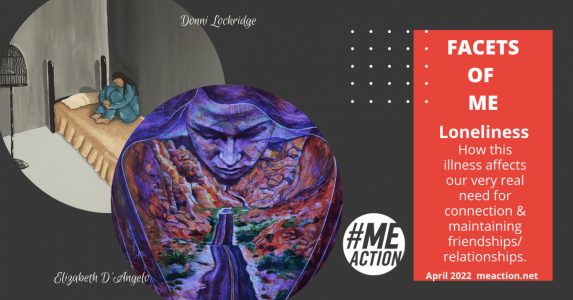
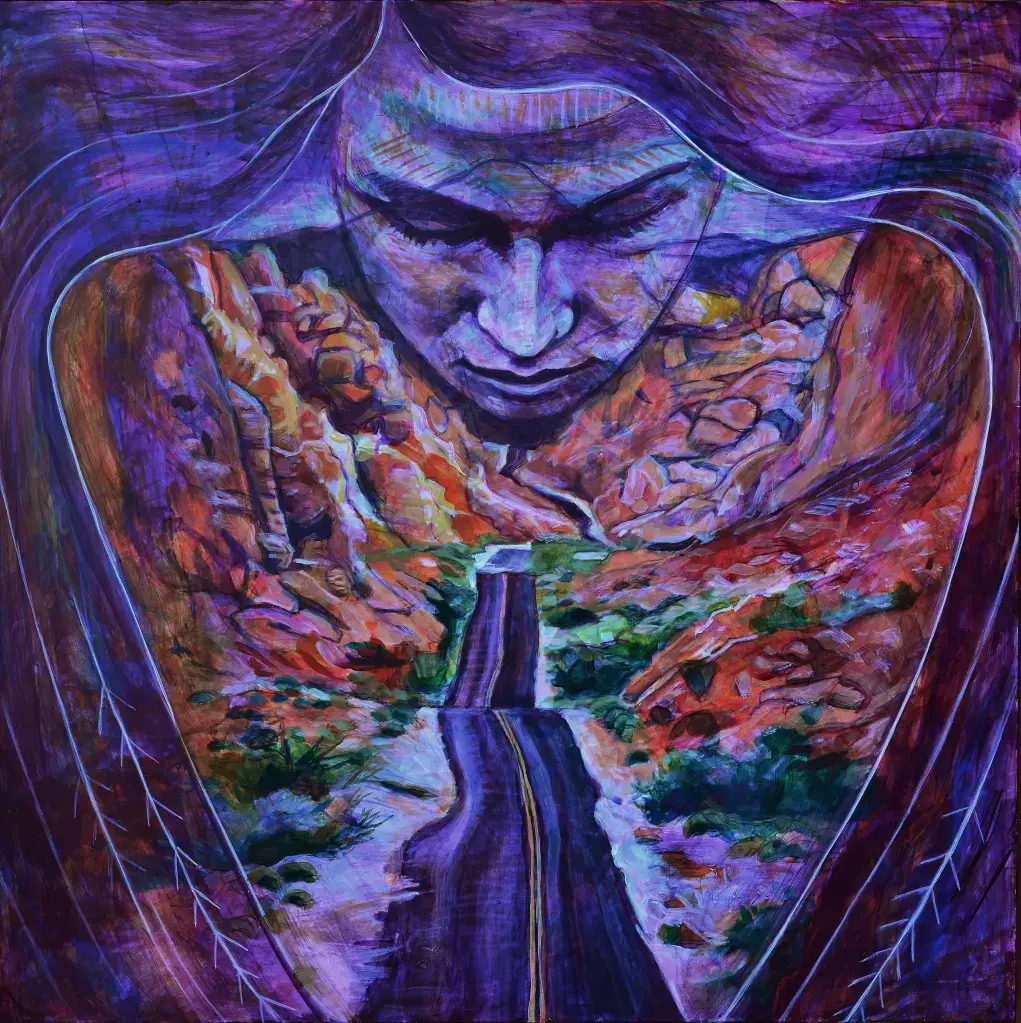
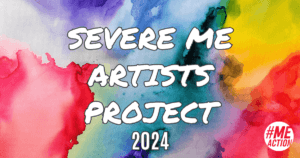
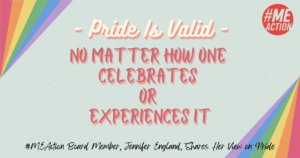
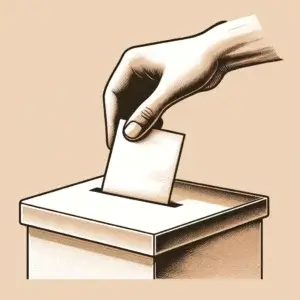
5 thoughts on “Facets of ME: Loneliness”
My partner/caregiver has tried some groups but finds that they are mostly people who’s partners are not as severe as I am.
People with more severe partners have different issues.
Is there a group for caregivers of the more severe that he would have more in common with ? Thx.
Would it be feasible to establish an area within #ME Action for people looking for e-mail friends? The closest friendship I have had since becoming moderate to severe was with another chronically ill woman who died several years ago. We had an understanding without explanation. I have abandonment/rejection issues due to 27 years with ME, and it’s difficult to approach new people. I’ve tried different Facebook groups, but their focus was on their disease and treatment, not friendship, or they had already formed into a clique and weren’t welcoming. An individual could submit a short summary of themselves and perhaps what they were seeking from interactions. Maybe, something like this exists and I’m unaware of it. Thank you!
Ooh I love that idea!
Such a great article! I love the care it took to produce this whilst dealing with ME.
The loneliness of my life during my last really big crash/trough was what drove me to write the character of Jan into my first Falls Mystery once I was well enough (relatively) to start working on the novel again (years later).
I wanted readers to understand how isolated our lives are, how much we crave human interaction and how little of it we can tolerate most days. How emotions build up inside our cages until we can’t see past the bars and yet dread losing them for the essential supports they provide.
This is the first place in the book where she’s revealing that aspect of herself to the reader:
“She’d been on the chaise in the cantilevered sunroom all afternoon, soaking up the warmth while hiding her eyes from the bright day, swapping between dark glasses and an eye mask. Rolling over amid the pillows and afghans was an effort. She did it anyway for the sake of changing the view from uphill, into the setting sun, to downhill, so she could look toward shadows.
Shadows suited her today, with everyone she knew heading for the museum when she would be staying home alone, again. The gala guests were friends, neighbours, Terry’s co-workers. They shared more of his life than his own wife did.
What if the contrast between cranky, frumpy Jan and some sleek, tennis-playing harpy got to be too much for him? Would he walk out? Would he force her out of the house into a tiny apartment in Calgary, where she’d eke out a miserable existence on her ever-ebbing divorce settlement? Would he stay with her out of guilt…”
(When the Flood Falls, by J.E. Barnard, published by Dundurn Press)
It’s been wonderful knowing that, thanks to that book winning the Canadian Crime Writing Award in 2016, thousands of readers in dozens of countries have learned about ME and our lives through the character I based on myself and all of us.
And the friends I’ve made online since then know exactly where I’m starting from in terms of health & energy, since I had to ‘come out’ to national news media during the publicity phase. So they all know not to expect me to be like ‘your old self’ which my older (mostly gone) friends were always wishing I’d go back to being.
What I wish most is that each person with ME would find the friendships they need right at the start of their journey, instead of fluking into one or more after months or years of loneliness and hundreds of hours visiting online groups and trying to be social when we’re too exhausted to sit up or think.
(When the Flood Falls, by J.E. Barnard, published by Dundurn Press)
Comments are closed.